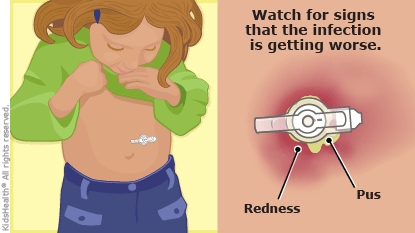G-Tube Infection: How to Care for Your Child
Even with the right care, the area around a G-tube can sometimes get infected. A child with a G-tube infection might have redness, warmth, soreness, and/or pus drainage around the tube. Some kids also get a fever. Usually, the infection is easy to treat with ointment or cream placed on the skin, or medicine given through the G-tube or mouth.


-
Use the medicine prescribed by the health care provider as directed.
-
If needed, you can give medicine for pain. If your health care provider says it is OK, use one of these medicines exactly as directed:
-
acetaminophen (such as Tylenol® or a store brand)OR
-
ibuprofen (such as Advil®, Motrin® or a store brand). Do not give to babies under 6 months old.
-
To care for the G-tube site:
-
Wash your hands well with soap and warm water before and after handling the G-tube and the area around it.
-
Gently clean the skin around the tube every day and as needed. Use warm water, soap, and a gauze pad. Rinse with warm water and dry the skin well with a clean towel.
-
Keep the area around the G-tube as dry as possible. If the health care provider told you to put gauze around the G-tube, make sure to change it often so that the skin stays dry.
-
To help prevent infection, wash and dry any reusable supplies (such as syringes and the extension set) as described in the instructions that came with them.
-
Schedule a follow-up appointment as directed.


Your child:
-
isn't getting better after 2–3 days of treatment
-
has redness spreading from the G-tube site
-
has symptoms that get worse
-
gets a fever again
-
has belly pain or swelling
-
is not passing gas or having bowel movements
-
has vomiting or diarrhea
-
has new symptoms

-
The G-tube comes out, and at least one of the following is true:
-
The G-tube was placed within the last 8 weeks.
-
You have not been trained to replace it.
-
You weren't able to replace it as you were trained.
-
Your child has severe belly pain.
-
Your child is vomiting and can't keep liquids down.
-
Your child has any of these signs of dehydration:
-
a dry or sticky mouth
-
peeing less
-
no tears when crying
-
dizziness
-
drowsiness

What can cause a G-tube infection? Kids can get an infection around the G-tube when:
-
The skin around the tube gets irritated. This can happen when stomach liquid leaks onto the skin or when the tube is too tight on the skin.
-
Equipment is not cleaned properly.
-
Caregivers do not wash their hands before caring for the tube or the surrounding area.